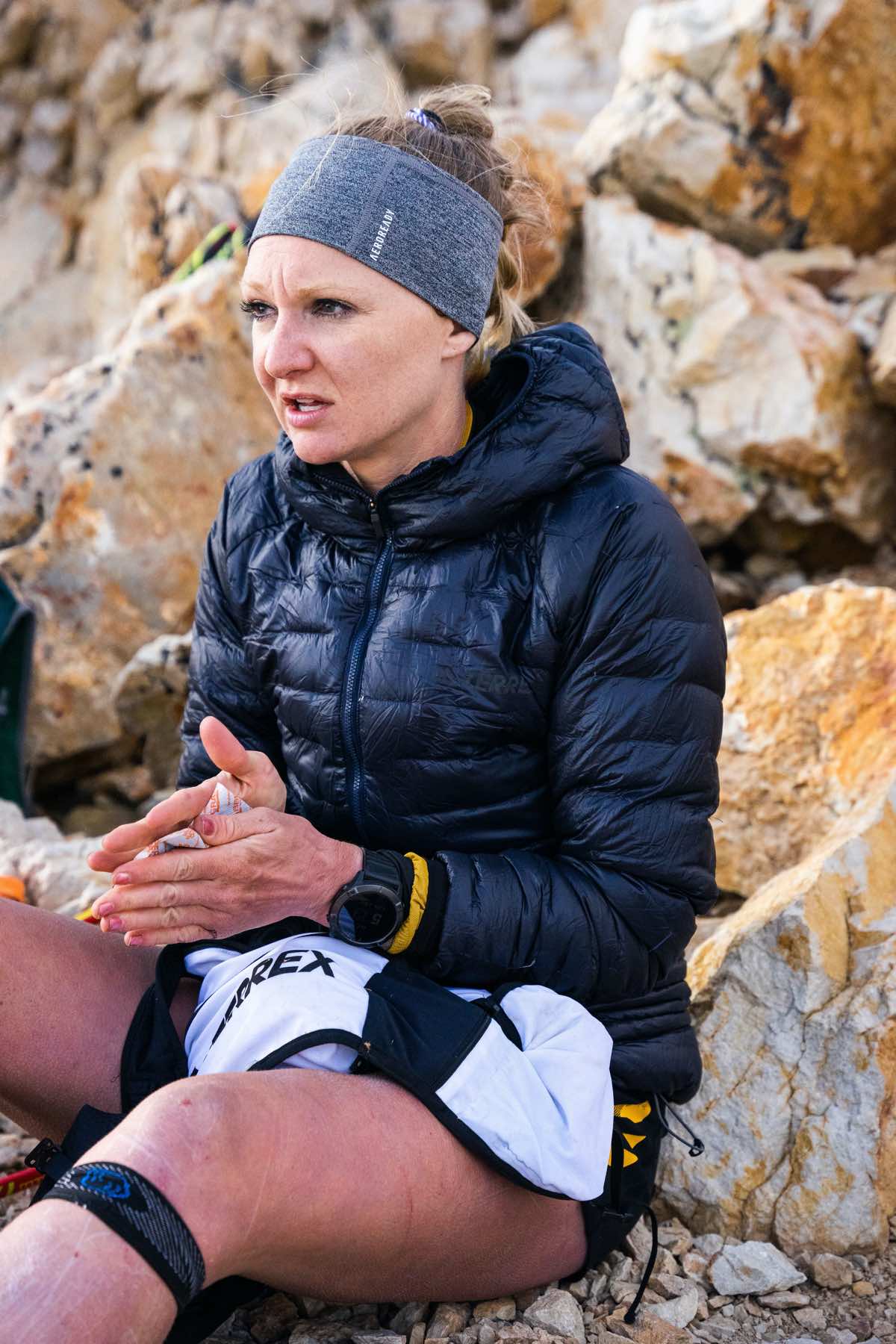For the second time this year and from October 1 through 3, Sabrina Stanley set the women’s overall fastest known time (FKT) on the Nolan’s 14 line in the Sawatch Range of Colorado in 48 hours and 49 minutes. Her effort bettered the women’s overall FKT of 50:32 set by Meghan Hicks in September of 2020. Sabrina completed the attempt in supported style, and this follows up on her first successful FKT attempt in August, where she ran 51:15.
The Nolan’s 14 line is a link-up of 14 mountains in excess of 14,000 feet in elevation. Athletes can connect the summits by whatever routes they choose, but routes commonly add up to about 95 miles in length, about 44,000 feet of climbing, and about half off trail.
The following is a written Q-and-A with Sabrina about a week after her finish. In this interview, Sabrina talks about why she chose to make a second FKT attempt and how she pursued it in business-like fashion.

Sabrina Stanley on her second successful Nolan’s 14 fastest known time attempt. Photo: Rabbitwolf Creative
iRunFar: Okay, so two successful Nolan’s 14 attempts and a boat load of training on the Nolan’s course and at high altitude all in one summer, are you officially tired now? Please tell me you’re sitting on the couch!
Sabrina Stanley: I am tired, but not too tired to go back and do it a third time if necessary.
iRunFar: What made you decide to give Nolan’s a second attempt at all, let alone in the same year?
Stanley: I set out saying I was going to get the Nolan’s FKT. I never said I wanted to do Nolan’s purely to do Nolan’s. It is never about the route for me, I can explore and appreciate the route in training. I wanted the FKT. To hold it for only a month was a slap in the face for everything I had sacrificed to hold it, so I decided to go back and get it again.
iRunFar: How did you turn things around both physically and mentally between the two attempts? I think it’s fair to say Nolan’s has a huge impact on one’s body and brain, and most people who get through it take quite a long time to recover.
Stanley: My desire to reclaim the FKT was stronger than my physical exhaustion. Mentally, I never felt beat down by Nolan’s. If anything, the first and now the second attempt have shown me again that I have the power to tune out my body and push through. I keep looking for a mountainous challenge that halts me in my tracks. There is a lot of hype around Nolan’s. It’s tough, but not impossible.
iRunFar: What pieces of the Nolan’s puzzle, be it your route, nutrition, hydration, or other logistics, did you focus on evolving and improving for your second attempt?
Stanley: I returned to the course for seven days in mid-September to revisit some sections I struggled with during my first attempt. I was much more strategic with my second attempt and aware of my pace every step of the way. In my first attempt, I ran and hiked by feel, loosely paying attention to pace.
iRunFar: Could you share some thoughts about how the experience was out there? Maybe bring us onto a mountain or two with you?
Stanley: It was a determined, constant, steady progress. There was a steadiness to it that surpassed time. I methodically checked one mountain off at a time, and then focused on the next. Huron Peak was a blast, Cordis Hall paced me and we flew. Cordis also paced me for La Plata Peak, which was insanely windy and by far the coldest mountain.
iRunFar: I am interested in the night and the cold! An October attempt meant between 11 and 12 hours of headlamp time and some cold temperatures up high. Can you share what those elements were like for you?
Stanley: I knew it was going to be cold and windy. I honestly just turned my brain off to everything and focused on making forward progress. I didn’t feel anything but the drive to get to the finish.
iRunFar: Funny or fascinating stories, we need stories! Wildlife encounters, hallucinations, best and worst things you ate, best and worst jokes your pacers told you, do you have a couple good stories?
Stanley: My team and I were on a mission. We were doing Nolan’s not for the adventure or the experience, we were there to get the job done. Cordis and I came across one porcupine heading up La Plata, and then my pacer Devo Derby and I spotted 10 mountain goats three quarters of the way up Mount Massive. Unfortunately, my good stories are in short supply since this was purely a business trip.
iRunFar: You seemed pretty hungry after your first attempt to do more and better on Nolan’s. Do you now feel satisfied? Will you head into the winter feeling like you did what you wanted this year?
Stanley: I can still run Nolan’s faster. I knew this second attempt wasn’t going to be my best work. From the start of my first attempt to the finish of my second attempt it was only 54 days, and there was going to be a lot of running in the dark and the temperatures would slow me down. At the same time, I was confident that I could show up, do Nolan’s again, and regain the FKT, so I figured I would. I won’t be satisfied until I do Nolan’s properly, meaning on fresh legs and at the right time of year. There is still time before the winter hits, so time will tell if I get out of this year what I set out to do.

